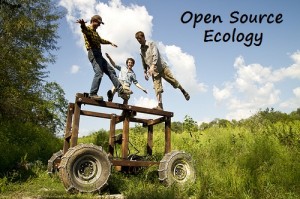Published June 27, 2014

Playfully working and communing at Open Source Ecology. Photo by Sean Church, attribution only required, see https://www.flickr.com/photos/sean_church/4919458248/sizes/n/
In our quest for community and NLRBE-style living and promotion, my family and I have been intrigued again with the idea of living in an intentional community someday.
And we’ve been particularly curious about the community being an integral part of a not-for-profit, 501(c)(3) entity. That is, I have wondered about the feasibility of establishing a single legal entity, a 501(c)(3), that contains both relevant nonprofit work and a community doing that work. There are many reasons for this, including potential simplicity and financial and tax advantages.
But the intrigue comes, in part, from how much we believe we might enjoy living in a nonprofit, mission-focused, egalitarian community. We want egalitarianism, as this jibes so well with our NLRBE values. But we also want our daily work to be non-profit NLRBE promotion related, as opposed to for-profit, and would enjoy being around those similarly focused.
I know there are separate LLC, partnership-style (versus egalitarian) communities, which do focus most of their daily work on legally distinct, 501(c)(3) entities. Take, for example, the Sowing Circle Community, in California, with its focus on the Occidental Arts and Ecology Center, a 501(c)(3).
And I wonder about the legal viability of having 501(d) egalitarian community members focused primarily on the work of a similarly distinct 501(c)(3).
|
*Important Reminder* |
However, I fear it might be challenging logistically to make this kind of 501(d)/501(c)(3) setup work in a way that is both financially sustainable and legally viable, let alone as simple or financially enabled as an all-in-one 501(c)(3) might be.
For example, it may be the case that one of the few ways to achieve that would be to try to set-up such work up so that 501(d) members are considered either volunteers, or workers for the 501(d), with the 501(d) acting as an independent contractor relative to the 501(c)(3)). And yet there are many traps for the unwary in trying to achieve this. For more on some of the potential complications with 501(d) members focused primarily on separate 501(c)(3) work, search for the phrase “outside income” in the handout from my talk about egalitarian communities, which you can find by clicking here. Also, I expect I may cover this topic more in future blog posts.
In any event, as stated at the start, I have also wondered about the possibility, potential simplicity, potentially increased community nonprofit-mission commitment and focus, and potential financial and tax advantages, of establishing an all-in-one, community and nonprofit-focused 501(c)(3).
On the one hand, I have many concerns about the legal feasibility of such a venture. I briefly referenced those concerns in the same handout linked above. And I hope to explore such legal issues in more detail in future blog posts.
On the other hand, part of me really wants to believe an egalitarian-community-containing non-profit could be designed in such a way to function in a fully legal fashion, for all the reasons noted above.
That part of me likes to take comfort in organizations that appear to have at least somewhat similar aspirations. For example, Open Source Ecology and One Community Global, two organizations, the missions of which I am insanely inspired by and hope to describe in future blog posts.
Yet, in reality, I am not certain that these entities have necessarily cleared relevant legal hurdles. I could imagine ways they might have cleared some or even all, but I am not sure of this at present.
When I looked for some evidence to that effect on One Community Global’s website, for example, the only information I saw related to this issue was a page linking the organization’s 501(c)(3) filing documents. The page contained a reference to the fact that the entity used Legal Zoom to craft its documents. That and the wording as a whole left me with the impression that the organization may not have consulted an attorney about the potential legal complications of concern to me. (The wording read, “We are not accountants and are not providing this information as filing advice or counsel and it is our opinion that documents like this are something you should have reviewed by someone specializing in non-profit organization creation before submitting your own forms. In our case we used LegalZoom.”) Of course, I may be mistaken about my induction. And, even if not, this wouldn’t by itself necessarily mean they are in problematic territory. Still, I didn’t find what I read as reassuring as I would’ve liked.
That said, there is a part of me that is nonetheless grateful to see people experimenting with an idea that I myself am so intrigued with, as I watch from the sidelines, and research the topic further.
I certainly hope the idea can work legally, as much for the inspiring organizations mentioned above, as much as for my family and others, with the resulting increased intentional community options this would open up for us all.
If you’re intrigued and hopeful too, stay tuned . . . .
By Tiffany Clark, an activist attorney, public speaker, and author, working to help us transition to a more sustainable and equitable world. Tiffany lives and works in Sacramento, CA, with her husband, two sons, cat and dog. You can find out more about Tiffany, her activities, and her offerings, as well as read more of her writing, at www.tiffanyclarklaw.com.

“Nonprofit Egalitarian Communities? Some Initial Thoughts.” by Tiffany Clark is licensed under a Creative Commons Attribution-NonCommercial-ShareAlike 4.0 International License.
